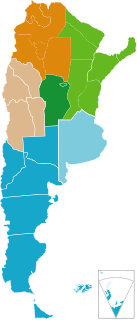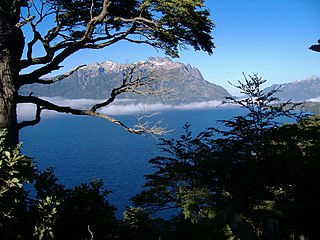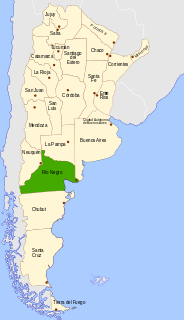The geography of Argentina describes the geographic features of Argentina, a country located in southern South America. Bordered by the Andes in the west and the South Atlantic Ocean to the east, neighboring countries are Chile to the west, Bolivia and Paraguay to the north, and Brazil and Uruguay to the northeast.

Argentina is provided with a vast territory and a huge variety of climates and microclimates ranging from tundra and polar in the south to the tropical climate in the north, through a vast expanse of temperate climate and natural wonders like the Aconcagua, the highest mountain in the world outside the Himalayas, the widest river and estuary of the planet, the huge and very mighty Iguazú Falls, some of the flattest and wide meadows-plains of planet Earth, culture, customs and gastronomies famous internationally, a higher degree of development, good quality of life and people and relatively well prepared infrastructure make this country one of the most visited of America.

San Carlos de Bariloche, usually known as Bariloche, is a city in the province of Río Negro, Argentina, situated in the foothills of the Andes on the southern shores of Nahuel Huapi Lake. It is located within the Nahuel Huapi National Park. After development of extensive public works and Alpine-styled architecture, the city emerged in the 1930s and 1940s as a major tourism centre with skiing, trekking and mountaineering facilities. In addition, it has numerous restaurants, cafés, and chocolate shops. The city has a permanent population of 108,205 according to the 2010 census.

Cerro Catedral is a mountain located 19 kilometres (12 mi) from San Carlos de Bariloche, and inside the Nahuel Huapí National Park, Patagonia, Argentina.

Huechulafquen Lake is a lake in Neuquén Province, Patagonian Argentina. This glacial lake is located in the Andean mountains in Lanín National Park some 25 kilometres from Junín de los Andes and 60 kilometres from San Martín de los Andes. It is one of Argentina's largest Andean lakes and is fed by glacier and meltwater streams and lakes.

Lake Puelo is a lake located in the northern part of Chubut Province, in Argentine Patagonia. Of fluvial-glacial origin, its deepest point is some 180 meters below the water level. The narrow L-shaped lake is surrounded by Lago Puelo National Park.

The Puelo River has its origin in Lake Puelo in Argentine, and flows north-west through the Andes into Chile and the Reloncaví Estuary of the Reloncaví Sound at the northern end of the Gulf of Ancud.

Aluminé Lake is a large and deep lake located in the Andes in the western part of Neuquén Province, Argentina, near the border with Chile. Aluminé Lake is fed by the outflow of Lake Moquehue and is the source of the Aluminé River whose waters ultimately reach the Atlantic Ocean. The tourist town of Villa Pehuenia is on the northern shore of the lake.

San Carlos de Bariloche Airport, also known as Teniente Luis Candelaria Airport, is an international airport serving the city of San Carlos de Bariloche, Río Negro, Argentina. The airport covers an area of 1,810 hectares and has a 12,000-square-metre (130,000 sq ft) terminal; it is located 13 kilometres (8.1 mi) out of the city.

Futalaufquen Lake is a large lake in Chubut Province, Argentina. Futalaufquen Lake is in the chain of lakes of the Futaleufú River system of Argentina which via Yelcho Lake and the Yelcho River flows into the Pacific Ocean in Chile. Located in the Andes, Lake Futalaufquen is three-lobed, of glacial origin, and occupies narrow valleys between glaciated peaks. It is located in the Andes within Los Alerces National Park. The name comes from the Mapuche language. "Futa" means great, and "laufquen" means lake.

Otto Meiling (1902–1989) was a German-born mountaineer who achieved many first ascents in Nahuel Huapi National Park and the surrounding area.

Nahuel Huapi National Park is the oldest national park in Argentina, established in 1934. It surrounds Nahuel Huapi Lake in the foothills of the Patagonian Andes. The largest of the national parks in the region, it has an area of 7,050 km2 (2,720 sq mi), or nearly 2 million acres. Its landscapes represent the north Patagonian Andean Zone consisting of three types, namely, the Altoandino, the Andino-Patagónico and the Patagonian steppe. It also represents small parts of the Valdivian Rainforest.

Marcos José Couch, Argentinean mountain climber, known for his professional achievements in mountains such as the Shishapangma in Tibet, or the Fitz Roy in Patagonia. Since 1987 he is a mountain guide and has been working internationally.

Lake Cholila is a lake in Chubut Province, Argentina. Lake Cholila is the uppermost of several large lakes in the Futaleufú River system of Argentina that via Yelcho Lake and the Yelcho River flows into the Pacific Ocean in Chile. The lake is of glacial origin and occupies a narrow east to west valley between glaciated peaks of the Andes.

Lake Rivadavia is a lake in Chubut Province, Argentina. Lake Rivadavia is the second lake, after Lake Cholila, in the chain of lakes in the Futaleufú River system of Argentina which via Yelcho Lake and the Yelcho River flows into the Pacific Ocean in Chile. Located in the Andes, Lake Rivadvia is of glacial origin and occupies a narrow north to south valley between glaciated peaks. All the lake except the northern tip is in the Los Alerces National Park. Argentina Provincial Highway 71 follows the eastern coast of the lake. Development consists only of a few campgrounds near the highway.

Lake Menéndez is a large lake in Chubut Province, Argentina. Lake Menéndez is in the chain of lakes in the Futaleufú River system of Argentina which via Yelcho Lake and the Yelcho River flows into the Pacific Ocean in Chile. Located in the Andes, Lake Rivadvia is Y-shaped, of glacial origin, and occupies two narrow valleys between glaciated peaks. The lake is in the Los Alerces National Park. There are no roads or other developments near the lake. Travel is by boat or foot. Lake Menéndez is noted for the extensive Alerce (Fitzroya) forests near the tips of its two arms.
Amutui Quimey Lake is a large reservoir in Chubut Province, Argentina. Amutui Quimey is in the chain of lakes of the Futaleufú River system of Argentina which via Yelcho Lake and the Yelcho River flows into the Pacific Ocean in Chile. The Futaleufú dam was completed and the reservoir filled in 1976 and the lake occupies a narrow valley between glaciated peaks. They hydroelectric facility produces 2.6 million megawatts per year, most of which is used for an aluminum refinery in the city of Puerto Madryn. Amutui Quimey Lake is in the Andes within Los Alerces National Park. The name of the lake comes from the Mapuche language. It means "lost beauty", referring to the beauty of the valley before the lake.


























